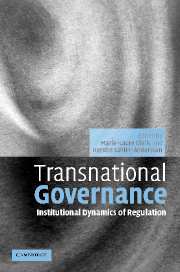Book contents
- Frontmatter
- Contents
- List of figures
- List of tables
- List of contributors
- Acknowledgments
- List of acronyms
- 1 Introduction: A world of governance: The rise of transnational regulation
- I Institutional forces
- II A dynamic transnational topography
- III Transnational governance in the making
- 12 Dynamics of soft regulations
- 13 Contested rules and shifting boundaries: International standard-setting in accounting
- 14 The international competition network: Moving towards transnational governance
- 15 The emergence of a European regulatory field of management education
- 16 Market creation and transnational rule-making: The case of CO2 emissions trading
- 17 Transnational NGO certification programs as new regulatory forms: Lessons from the forestry sector
- 18 Institutional dynamics in a re-ordering world
- References
- Index
14 - The international competition network: Moving towards transnational governance
Published online by Cambridge University Press: 22 September 2009
- Frontmatter
- Contents
- List of figures
- List of tables
- List of contributors
- Acknowledgments
- List of acronyms
- 1 Introduction: A world of governance: The rise of transnational regulation
- I Institutional forces
- II A dynamic transnational topography
- III Transnational governance in the making
- 12 Dynamics of soft regulations
- 13 Contested rules and shifting boundaries: International standard-setting in accounting
- 14 The international competition network: Moving towards transnational governance
- 15 The emergence of a European regulatory field of management education
- 16 Market creation and transnational rule-making: The case of CO2 emissions trading
- 17 Transnational NGO certification programs as new regulatory forms: Lessons from the forestry sector
- 18 Institutional dynamics in a re-ordering world
- References
- Index
Summary
Introduction
In 1945, antitrust was an American legal tradition with no impact beyond the national borders of the United States. American antitrust reflected the double belief that competition should be the highest organizing principle and that the economy functions best when competitors have limits for permitted activities. Outside the United States, competition was feared rather than fostered for its potentially disruptive and chaotic consequences.
Sixty years later, we can see that a major reversal of trend has taken place. Competition has become the name of the game, both in national and international economic spaces. About one hundred countries have today a competition policy and competition institutions that seem quite compatible, at first sight, with the American antitrust tradition. The last few years have also seen multiple attempts at fostering antitrust principles and institutions within the transnational space as well as initiatives to spread a “culture” of antitrust. Those have culminated in 2002 with the creation of the International Competition Network (ICN). The ICN is a virtual network organization where national and regional antitrust agencies collaborate in their fight for competition. It is quite open to inputs from experts, consultants, academics or even firms and industries and the principal aim of that network is to push along and further the establishment, the implementation and the monitoring of global and “seamless” practices and standards.
- Type
- Chapter
- Information
- Transnational GovernanceInstitutional Dynamics of Regulation, pp. 287 - 307Publisher: Cambridge University PressPrint publication year: 2006
- 17
- Cited by



